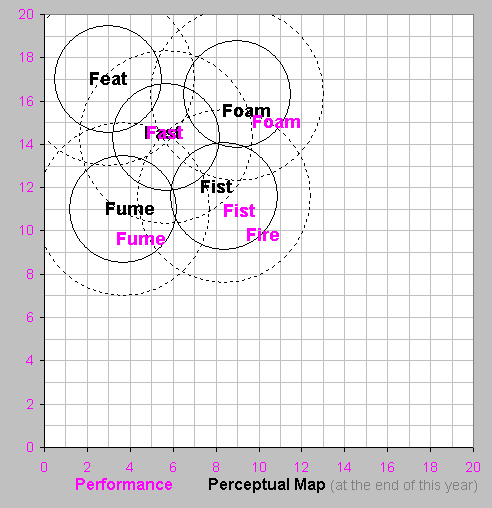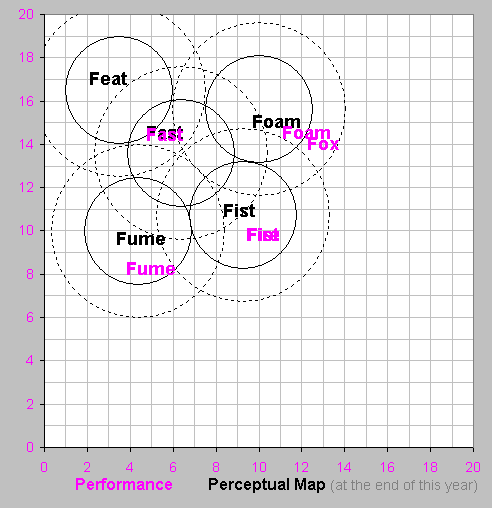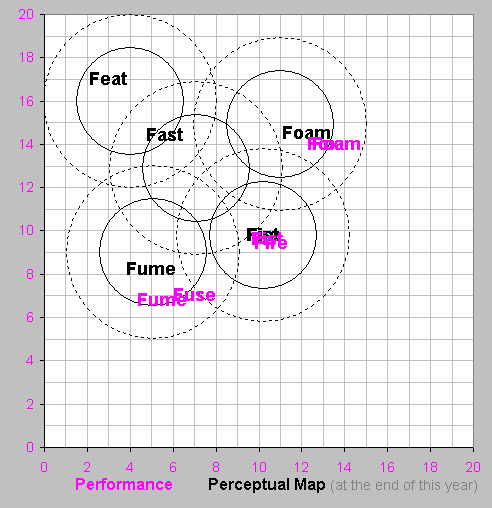This practice exercise will help you understand the relationships between business strategy, tactics, functional alignment, and the Capstone® simulation. We will use the Ferris team for this example.
Printable PDF Version for Distribution to Participants
You will execute your plan by inputting the decisions described below. At the same time, your competitors will execute their assigned plans. The practice exercise will take three rounds As each round is processed, you will evaluate the results and then input the next round's assigned decisions.
Upon completion of the practice rounds, the simulation will be reset to the beginning. You can then create and implement your own strategic plan for the actual competition.
We will team will adopt a Niche Differentiatior strategy that focuses upon the high technology segments (High End, Performance, and Size). We will gain a competitive advantage by distinguishing our products with an excellent design, high awareness, easy accessibility, and new products. We will develop an R&D competency that keeps our designs fresh and exciting. Our products will keep pace with the market, offering improved size and performance. We will price above average. We will expand capacity as we generate higher demand.
Premium products for the technology oriented customers: Ferris brands define the cutting edge. Our primary stakeholders are customers, stockholders, management, and employees.
We will keep our existing technology products (Fist, Foam, and Fume), phase out Fast and Feat, and introduce new technology new products in the High End, Performance and Size segments. Our goal is to offer technology oriented customers products that match their ideal criteria for positioning, age, and reliability.
We will spend aggressively in promotion and sales in the technology segments. We want every customer to know about our superb designs, and we want to make our products easy for customers to find. We will price at a premium. In the low technology segments we will exit gracefully, harvesting our Fast and Feat products as they exit the Low End segment.
We will grow capacity to meet the demand that we generate, avoiding overtime when possible. After our products are well positioned, we will investigate moderate increases in automation levels to improve margins, but never at the expense of our ability to reposition products and keep up with the high technology segments as they move across the perceptual map.
We will finance our investments primarily through stock issues and retained earnings, supplementing with bond offerings on an as needed basis. When our cash position allows, we will establish a dividend policy and begin to retire stock. We are somewhat adverse to debt, and prefer to avoid interest payments. We expect to keep assets/equity (Leverage ) between 1.5 and 2.0.
Follow the decisions below. After the practice rounds are complete and the competition rounds begin, you are free to choose a different strategy; you are not obligated to continue as a Niche Differentiator.
Fast - Tweak positioning to reduce age. Reduce reliability (MTBF) to reduce material cost. Example: Increase Performance by 0.1 and reduce MTBF by 1000 hours.
Feat - Leave positioning alone, allowing the product to age further. Reduce reliability (MTBF) to reduce material cost. Example: reduce MTBF by 1000 hours.
Fist - Improve positioning and reduce age. Hold reliability (MTBF) steady. Example: Increase Fist's performance by 1.1 and decrease size by 1.1.
Foam - Improve positioning and reduce age. Improve reliability (MTBF) to enhance demand. Example: Increase Foam's performance by 1.4, decrease size by 0.5, and increase MTBF by 1000 hours.
Fume - Improve positioning and reduce age. Hold reliability (MTBF) steady. Example: Increase Fume's performance by 0.5 and decrease size by 1.4.
New High End Product - Launch a new High End product, with a project length of 20 to 23 months (no later than December of next year.) Example: Name: Fire (replace the first NA in the list), positioned at leading edge of High End segment, say Performance 10.2, Size 9.8. Set MTBF in the middle of the High End reliability (MTBF) range: MTBF 23000.
Important: Under the rules of the simulation, the names of all new products must have the same first letter as the name of the company.
Important: With the exception of the new product, make certain that the projects complete during this year before December 31st. Under the rules, a new project can only begin on January 1st. If these projects do not complete before the end of this year, you cannot begin follow-up projects next year.

Perceptual Map from the Research & Development Spreadsheet: Product names in black indicate the product's current location, names in magenta indicate the product's revised position (with slight revisions, the names will overlap). Names of newly invented products appear in magenta.
Fast - Increase price, make cuts in promotion and sales budget. Forecast unit sales near last year's level. Example: Price $28.50, promotion budget $600, sales budget $600, and sales forecast 1100.
Feat - Increase price, make cuts in promotion and sales budget. Forecast a decrease in unit sales from last year due to the price increase and decrease in promotion and sales. Example: Price $23.50, promotion budget $600, sales budget $600, and sales forecast 1400.
Fist - Increase price, promotion budget and sales budget. Forecast an increase in unit sales over year. Example: Price $39.50, promotion budget $2000, sales budget $2000, sales forecast 400.
Foam - Increase price, promotion budget and sales budget. Forecast an increase in unit sales over year. Example: Price $34.50, promotion budget $2000, sales budget $2000, sales forecast 490.
Fume - Increase price, promotion budget and sales budget. Forecast an increase in unit sales over year. Example: Price $34.50, promotion budget $2000, sales budget $2000, sales forecast 440.
New High End Product - No change required because the product will not emerge from R&D until next year.
Production schedules will plan for eight weeks of inventory. That is, have enough inventory on hand to meet demand eight weeks beyond the sales forecast. This requires a 15% inventory cushion (8/52 = 0.15). For example, suppose Marketing forecasts demand at 1000, and you have 100 units in inventory. You want 1000 x 115% = 1150 available for sale. Since you have 100 on hand, you would schedule 1050 for production.
If you cannot meet demand, sales go to competitors. Therefore, you want to plan for the upside as well as the downside. Your proforma balance sheet will forecast about eight weeks of inventory. You hope that your actual sales will fall between your sales forecast and the number of units available for sale.
For each product, schedule production using the formula:
(Unit Sales Forecast X 1.15) - Inventory On Hand.
Fist - Sell 200 to 300 units of capacity. Fist has too much capacity, and given our new product it is unlikely that we will need 900 units of capacity in the future.
Make no other plant improvements to capacity or automation at this time.
Your fiscal policies should maintain adequate working capital reserves to avoid a liquidity crisis. Working capital can be thought of as the money that you need to operate day-to-day. In Capstone® working capital is current assets (cash + accounts receivable + inventory) - current liabilities (accounts payable + current debt). If you run out of cash because your sales are unexpectedly weak, an Emergency Loan will be issued.
Here are some guidelines to help you avoid an Emergency Loan . Your proforma balance sheet predicts your financial condition at the end of this year. Make conservative sales forecasts. Do not rely on the computer prediction. Override it with a forecast of your own. If you are conservative, it is unlikely that your worst expectations will be exceeded. Next, build additional inventory beyond your conservative expectations. This forces your proforma balance sheet to predict a future where your sales forecast comes true and you are left with inventory. (If you sell the inventory, that's wonderful.) On the Finance spreadsheet, issue stock, bonds or current debt until the December 31 Cash Position for the upcoming year equals at least five percent of your assets, as displayed on the proforma balance sheet. This creates an additional reserve for those times when your worst expectations are exceeded and disaster strikes.
As you gain experience with managing your working capital, you will observe that the guidelines above make you somewhat "liquid," and you may wish to tighten your policy by reducing cash and inventory projections. That is fine. The better your marketing forecasts, the less working capital you will require.
Pay a dividend between $0.75 and $1.25.
Do not issue current debt. If you are short of cash issue stock.
Save decisions (select "directly to the website").
Fast - Tweak positioning to reduce age. Reduce reliability (MTBF) to reduce material cost. Example: Decrease Fast's size by 0.1 and reduce MTBF by 1000 hours.
Feat - Leave positioning alone, allowing the product to age further. Reduce reliability (MTBF) to reduce material cost. Example: reduce MTBF by 1000 hours.
Fist - Improve positioning and reduce age. Hold reliability (MTBF) steady. Example: Increase Fist's performance by 1.1. and decrease size by 1.1.
Foam - Improve positioning and reduce age. Improve reliability (MTBF) to enhance demand. Example: Increase Foam's performance by 1.4, decrease size by 0.5, and increase MTBF by 1000 hours.
Fume - Improve positioning and reduce age. Hold reliability (MTBF) steady. Example: increase Fume's performance by 0.5 and decrease size by 1.4.
New High End Product - Note that the new product's row is yellow instead of green, and that you cannot change these cells. This is because your product will not emerge from R&D until its current project completes. Under the rules of the simulation, new R&D projects cannot begin until the old one completes.
New Performance Product - Launch a new Performance product, with a project length of 20 to 24 months (no later than December of next year.) Example: Name: Fox (replace the first NA in the list), positioned beyond the leading edge of Performance segment, say performance 13.0, size 14.0. Set MTBF near the top of the Performance reliability (MTBF) range: MTBF 26000.
Important: Under the rules of the simulation, the names of all new products must have the same first letter as the name of the company.
Important: Under the rules of the simulation, the names of all new products must have the same first letter as the name of the company.

Fast - Hold price, promotion and sales budgets. Forecast decreased unit sales over last year because the price was not reduced to match the segment's desire for cheaper products. Example: Price $28.50, promotion budget $600, sales budget $600, and sales forecast 1000.
Feat - Reduce price, and hold promotion and sales budgets. Forecast increased unit sales due to the price cut. Example: Price $21.50, promotion budget $600, sales budget $600, and sales forecast 1400.
Fist - Drop price $0.50. Hold promotion budget and sales budget. Forecast a moderate increase in unit sales. Example: Price $39.00, promotion budget $2000, sales budget $2000, sales forecast 500.
Foam - Drop price $0.50. Hold promotion budget and sales budget. Forecast a moderate increase in unit sales. Example: Price $34.00, promotion budget $2000, sales budget $2000, sales forecast 500.
Fume - Drop price $0.50. Hold promotion budget and sales budget. Forecast a moderate increase in unit sales. Example: Price $34.00, promotion budget $2000, sales budget $2000, sales forecast 450.
New High End Product - No change required because the product will not emerge from R&D until the end of this year, and it does not have production capacity.
New Performance Product - No change required because the product will not emerge from R&D until next year.
For each product, schedule production using the formula:
(Unit Sales Forecast X 1.15) - Inventory On Hand
New High End product - Buy 600,000 units of capacity by entering 600 in the Buy Sell Capacity cell. Set an automation level of 5.0.
Make no other improvements to capacity or automation at this time.
Look at the proforma balance sheet, and add together your cash and inventory accounts. Apply the following rule of thumb. Keep between 15% and 20% of your balance sheet assets in cash plus inventory. You do not care about the mix, but you do want to have adequate reserves to cover unexpected swings in inventory.
Adjust your cash position to meet the guideline from Round 1. If you are cash poor, issue additional stock to cover the investment in new capacity. If you are cash rich, pay dividends.
Do not issue current debt.
Save decisions (select "directly to the website").
Fast - No change required. Fast is entering the Low End segment. Next round, reduce reliability (MTBF) to 12000 hours.
Feat - No change required.
Fist - Improve positioning and reduce age. Hold reliability (MTBF) steady. Example: Increase Fist's performance by 0.2 and decrease size by 0.2.
Foam - Improve positioning and reduce age. Hold reliability (MTBF) steady. Example: Increase Foam's performance by 1.4, decrease size by 0.5.
Fume - Improve positioning and reduce age. Hold reliability (MTBF) steady. Example: Increase Fume's performance by 0.5 and decrease size by 1.4.
New High End Product - Tweak positioning and reduce age. Hold reliability (MTBF) steady. Example: Increase Performance by 0.4 and decrease size by 0.4.
New Performance Product - No change required. The product will emerge later this year.
New Size Product - Launch a new Size product, with a project length of 20 to 24 months (no later than December of next year.) Example: Name: Fuse (replace the first NA in the list), positioned at leading edge of the Size segment, say Performance 7.0, Size 7.0. Set MTBF near the middle of the Size reliability (MTBF) range: MTBF 19000.

Fast - Reduce price, maintain promotion and sales budgets. Fast is now a Low End product, but since Fast is not a "good" Low End product, plan for poor sales. Example: Price $23.00, promotion budget $600, sales budget $600, and sales forecast 800.
Feat - Reduce price, maintain promotion and sales budgets. Forecast unit sales near last year's level. Example: Price $20.00, promotion budget $600, sales budget $600, and sales forecast 1150.
Fist - Hold price high, maintain promotion and sales budgets. Forecast improved unit sales. Example: Price $38.00, promotion budget $2000, sales budget $2000, sales forecast 900.
Foam - Hold price high, maintain promotion and sales budgets. Forecast improved unit sales. Example: Price $33.00, promotion budget $2000, sales budget $2000, sales forecast 950.
Fume - Hold price high, maintain promotion and sales budgets. Forecast improved unit sales. Example: Price $33.00, promotion budget $2000, sales budget $2000, sales forecast 950.
New High End product - Price high, mirror promotion and sales budgets of other high technology products. Forecast good unit sales. Example: Price $38.00, promotion budget $2000, sales budget $2000, sales forecast 800.
For each product, schedule production using the formula:
(Unit Sales Forecast X 1.15) - Inventory On Hand
Important: As your new product is coming out sometime during the year, you might not be able to use the above formula - new products cannot begin production prior to their revision (release) date. Should the number you enter into the production schedule turn red, reduce the schedule until the red number turns black.
Fast - Sell 1,000,000 units of capacity by entering -1000 in the Buy Sell Capacity cell.
Feat - Sell 700,000 units of capacity by entering -700 in the Buy Sell Capacity cell.
Fist - Increase automation by 1.0 or 2.0 points.
Foam - Increase automation by 1.0 or 2.0 points.
Fume - No change required.
New High End Product- No change required.
New Performance Product - Buy 600,000 units of capacity by entering 600 in the Buy Sell Capacity cell. Set an automation level of 5.0.
New Size Product- No change required. The product will emerge later this year.
Important: There is a one year lag between purchase and use of new capacity and automation for both new and existing products.
You may have cash on hand to cover your plant and equipment investment. If not, issue stock to cover the shortfall.
Look at the proforma balance sheet, and add together your cash and inventory accounts. Apply the following rule of thumb. Keep between 15% and 20% of your balance sheet assets in cash plus Inventory. You do not care about the mix, but you do want to have adequate reserves to cover unexpected swings in inventory.
Adjust your cash position to meet the guideline from Round 1. If you are cash poor, issue stock. If you are cash rich, pay dividends and buy back stock.
Do not issue current debt.
Save decisions (select "directly to the website").
Your instructor might want you to play another practice round. If so, continue the Niche Differentiation vision.
Having executed the plan for two or three rounds, you are now in a position to analyze it. Consider the following questions:
What are this plan's strengths? Weaknesses?
How will competitors respond to your actions?
How can you influence competitors to avoid competing with you directly?
Which performance measures support this plan?
What is the long range potential of this plan? Its future sales volume? Its future profitability?
How can you best coordinate this plan as a team?